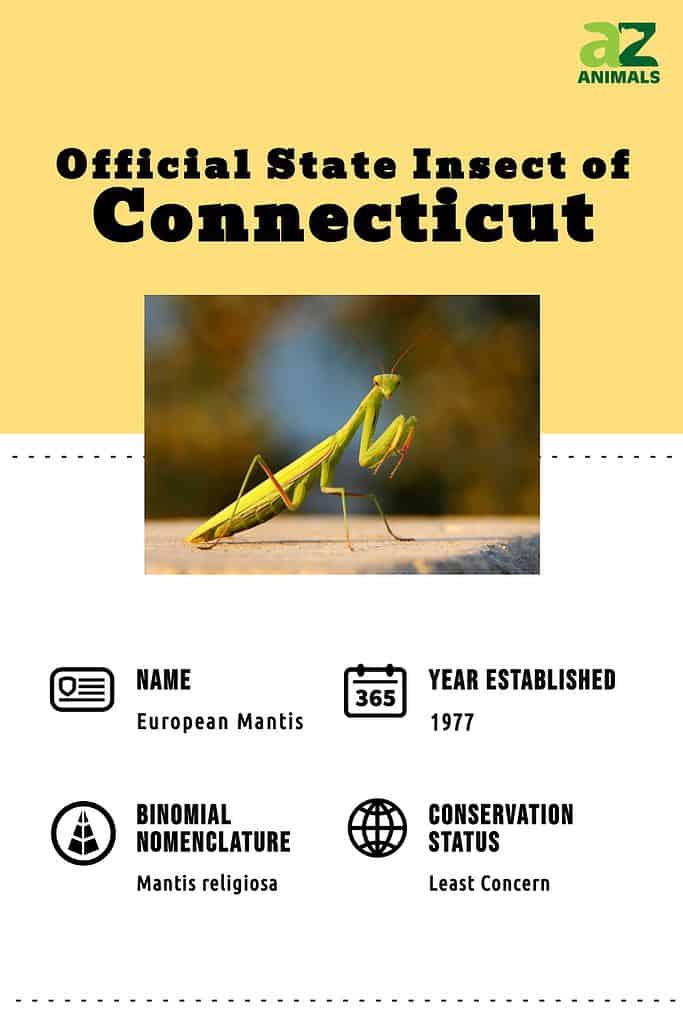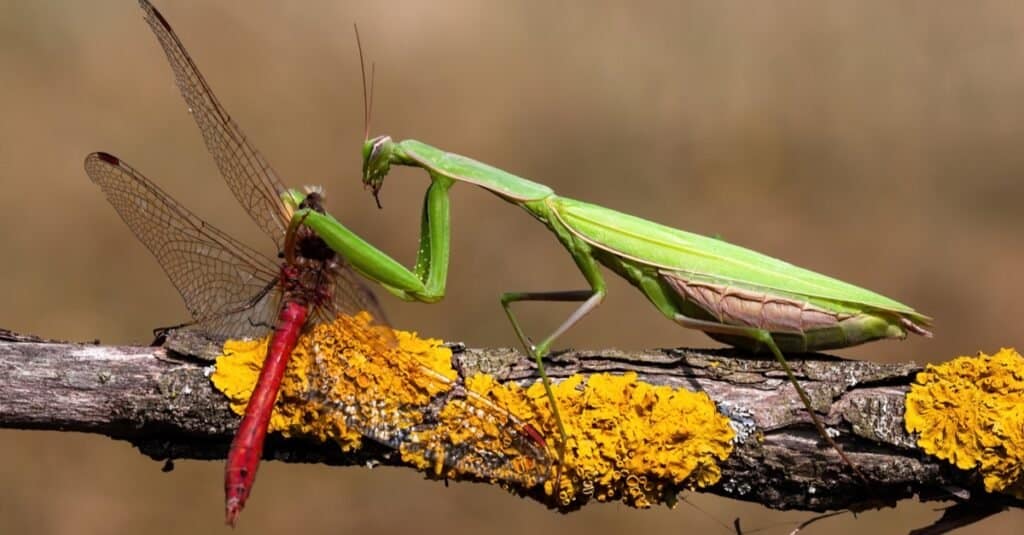Connecticut, one of the smallest states in the union, is home to numerous historical towns, quaint remote villages, and breathtakingly beautiful natural areas. Along with great places to visit, Connecticut is home to incredible flora and fauna. Today, we’re diving into Connecticut’s state insect! The official Connecticut state insect is the European mantis.

The European Mantis, also known as Mantis religiosa, is a species of mantis that originated in Europe but has now spread to North America. In the 1600s, it was brought from Europe to North America to fight plant pest insects. It is regarded as the basis for a mantis. Let’s talk about everything there is to know about this creature!
European Mantis in Connecticut

Green European mantis, Mantis religiosa, feeding on a red
Dragonfly
.
©WildMedia/Shutterstock.com
On October 1, 1977, the European “praying” mantis was officially named the State Insect. In Connecticut, the European mantis isn’t a native species. They first appeared in Northern Africa, Southern Europe, and temperate Asia. Yet, from the beginning of May or June until the arrival of winter weather, when they quickly perish, this mantis can be spotted all over the state.
Connecticut’s State Insect: the European Mantis
The European mantis (Mantis religiosa) is a sizable hemimetabolic insect belonging to the biggest family of the order Mantodea, the Mantidae, often known as “mantids.” Because of the peculiar position of their legs in resting positions, they are often called praying mantis.
Both males and females have two pairs of wings on their long bodies. The most distinguishing characteristics of all Mantodea are their unique legs, which have undergone extensive modification to capture and confine swiftly moving or airborne prey effectively.
The European mantis has a long, slender body, two sets of wings, and long, elongated limbs. The forelegs of the insect are referred to as “raptorial legs” since they are designed for catching prey. Sharp spikes added to the raptorial legs stop prey from fleeing.
Even though M. religiosa male and female animals often differ in size and weight by around three inches, male animals have larger antennae and eyes. They have simple eyes in addition to the complex ones that face forward on their heads. Additionally, the males’ three dorsal ocelli are more noticeable than the females’.
Males are frequently observed to be more physically robust and energetic than females. Adult females typically weigh too much and are too big to fly using their wings. The European mantis has a wide range of colors.
The color of this species ranges from green to brown to yellow to even black. The head can move over 180 degrees and is quite mobile. The female belly has six parts, whereas the male abdomen has eight.
European Mantis Habitat

A female European mantis.
©Tatyana-Sanina/Shutterstock.com
With a fairly wide geographic range, the European mantis can be found in Europe, Africa, Asia, and (perhaps) Australia. Additionally, the species was brought to North America and now exists in the United States and Canada.
There are about 12 different subspecies of European mantis in the species’ territory. The European mantis can be found in natural and man-made environments, including open valleys, roadside medians, and even urban gardens.
The species is often found in warm, open environments with various herbaceous and bushy plants, tall grass, and sunlight. The adults may live in semi-arid desert areas and withstand extremely high temperatures. The ootheca, or egg case, may withstand long winters.
European Mantis Diet
The European mantis eats meat. It mostly feeds on insects such as bees, beetles, locusts, moths, butterflies, and crickets. The mantis could also feed on spiders and other invertebrates. If the arachnid is big enough, the mantis may become the victim in these interactions.
This creepy crawler hunts prey in ambushes. The mantis, which blends into its surroundings, waits still while constantly watching for movement. As soon as its target is within striking distance, the mantis attacks and seizes its meal with its raptorial legs. The prey is consumed while it is still alive and moving since it cannot flee due to the mantis’s strong spines on its legs.
The European mantis is renowned for its propensity towards cannibalism. In addition to females eating males while mating, nymphs have been known to start attacking and eating one another in congested areas.
Up Next
- Connecticut’s 7 Best Birdwatching Spots This Summer
- 10 Amazing Waterfalls in Connecticut
- Discover the Deepest Lake in Connecticut
- 12 Captivating Turtles in Connecticut
The photo featured at the top of this post is © Tatyana-Sanina/Shutterstock.com
Thank you for reading! Have some feedback for us? Contact the AZ Animals editorial team.






